Description
Black plays a dubious opening, and White plays accurately. As a result, Black ends up with a backward e pawn, and weak dark squares on the kingside. White forces Black’s pieces into an awkward defensive position. Black is able to defend his e pawn, but is unable to respond when White suddenly maneuvers his queen to exploit the dark square weaknesses on the other side of the board.
1.e4 e6 2.d4 d5 3.Nc3 Nf6 4.Bg5 Be7 5.e5 Ne4
Although, this variation seems strange. it’s been played at high levels. However, it’s played way less often than 5...Ne7.
Surprise Weapons
After a little research, you’ll find that some variations have been played by chess grandmasters, but way less frequently than more solid alternatives. This often means they are used as “a surprise weapon,” and there’s a good chance there’s something about them that doesn’t hold up too well against correct play. Oftentimes, there’s just a single variation that comes close to refuting the idea, and the opponent has to know that line or find it over the board. Otherwise, the adventurous player often gets a good game.
Fortunately, I know this line and quickly obtained a large advantage.
6.Bxe7 Qxe7 7.Nxe4 dxe4 8.Qe2
Question:
This is a great move. I knew it from my opening research … otherwise, there’s a good chance I wouldn’t have found it over the board, as it doesn’t easily suggest itself. The move 8.Qe2 has three key points. Can you see what they are?
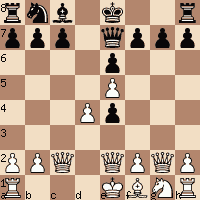
8. Qe2 defends, attacks, and prepares 000.
A Great Multipurpose Move
Qe2pressures theepawn.Qe2protectsb2, so that if Black playsQb4check, White responds withc3.Qe2prepares to castle queenside.
8...Bd7
Black prepares to defend his e pawn.
9.0–0–0 Bc6 10.g3 f6 11.exf6 gxf6
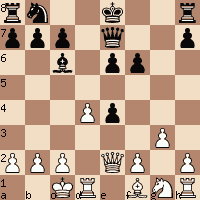
Black now has weak dark squares on the kingside that White will harvest later on. This is frequently the case with square weaknesses – you can’t exploit them immediately, but take note of them, and opportunities will often arise later in the game.
12.Bg2 f5
What’s the best move?
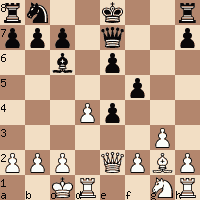
13.f3!
This move completely exposes the unsound philosophy of the opening. Black is forced to capture on f3, and as a result, he end up with a backward e pawn. White applies tremendous pressure to this static weakness, and it is the complete focus of play for the next 10 moves. Structural problems need to have some kind of compensation. Some openings allow pawn structure problems, but only when they are balanced with piece activity, or the opponent has equivalent problems to solve. In this case, Black has no compensation for his backward e pawn, so White is able to bear down on the weakness, and force Black into a very awkward position.
13...exf3 14.Bxf3 0–0 15.Nh3
The knight has a great post on f4 where it will pressure Black’s e pawn, and cannot be dislodged from that square.
15...Nd7
An interesting decision. Although his current position doesn’t inspire confidence, Black is a strong player. We’ve played several speed games on the internet, and he’s won more than once.
Although the move 15...Nd7 isn’t best, it’s a good practical try. Black has a backward e pawn and doesn’t want to spend the entire game defending a static weakness, so he’s looking for attacking chances on the b file. That means I wouldn’t take the Bishop, if I thought Black’s b file play would become significant or he could easily undouble his pawns.
16.Bxc6 bxc6
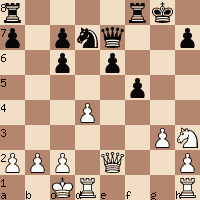
Doubled Pawns
Let’s discuss the exciting topic of doubled pawns. The first thing to know is that they often require a high level of skill to handle properly. The side with the doubled pawns usually has two compelling priorities:
Goals for Doubled Pawn Positions
- Undouble the pawns.
- Use the open file.
The side with the doubled pawns usually has to be able to achieve one or both of these goals, or end up with a bad game.
Mobility and Cooperation Issues
Here are two more key points:
- The mobility of the backward pawn is reduced to zero, until the forward pawn moves.
- Communications along the 2nd and 3rd ranks are blocked by the doubled pawns, This often makes it difficult to respond to multiple threats if the opponent skillfully works sides of the board.
17.Nf4 Rfe8 18.Rhe1 Nf8 19.Qc4 Qd6 20.Re5
Note that since Black’s pawns are on light squares, White’s pieces are naturally attracted to find solid posts on the dark squares.
Black’s game would be easier to play if both dark square bishops were still on the board, That would enable him to fight for control of some of the dark squares and also have the option to chase White’s pieces away or trade them off.
20...Rab8 21.c3
This move strengthens the center and prevents ...Rb4.
21...Kg7 22.Rde1 Kf6
What’s the best move?
23.Qe2
Many consider Aron Nimzovich to be the father of modern chess strategy. He calls this an “alternating maneuver” and it is a very powerful concept to add to your understanding.
Alternating maneuvers are extremely powerful !
Here’s how they work …
The side with the advantage builds up pressure against a static weakness. In this game, we’re specifically talking about pressure against e6. The inferior side has to place his pieces defensively in order to defend the weakness. As a result: His pieces often don’t work well together. He loses mobility, and the ability to respond quickly to new threats on other parts of the board. The superior side maximizes pressure on the weakness, then suddenly begins to maneuver against the other side of the board. Because of his lack of mobility, and lack of cooperation between his pieces, the inferior side is often unable to respond to threats made to another part of the board, and his position falls apart.
23...Rb5 24.Qh5
This is a good moment to remember the dark squared weaknesses on this side of the board we brought to your attention after Black’s 11th move. There is no defense to all the different threats in this position.
24...Kg7 25.Qg5+ Ng6 26.Rxe6 Rxe6 27.Rxe6 Qd7 28.Qf6+ Kg8 29.Nxg6 hxg6 30.Re7 resigns.
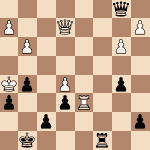
Ich liebe schah zu spielen, aber ich bin zu alt zu eine schah schule zu gehen. Diese Spiel hilft mir, aber hier muss ich auch taktik lernen und ich wurde mich frohen, wenn mir etwas geschiht wurde oder sie wurden etwas auf den internet Seite etwas machen. Ich danke Ihnen fur den spiel aus ganzen Herzen.
Although, this variation seems strange. it’s been played at high levels. However, it’s played way less often than 5…Ne7. Isn’t the bishop already occupying e7?
5…Nd7